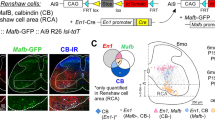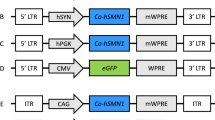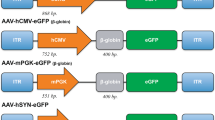Abstract
We investigated genes expression by retrograde axonal transport of replication-defective adenoviruses carrying genes for LacZ (AdLacZ) and Bcl-2 in motor neurons of transgenic mice expressing mutant human Cu/Zn superoxide dismutase (SOD1) gene containing a substitution of alanine for glycine at position 93. We found that intramuscular injection of AdLacZ into the tongue of mutant SOD1 transgenic mice and their wild-type littermates at various ages results in high expression of the transgene and similar time course of expression in hypoglossal cranial nerve nuclei, suggesting no difference in the behavior of the transgene expression between the two groups. Subsequently, we employed a molecular switching cassette for Bcl-2 designed to express Bcl-2 by Cre-loxP recombination using adenoviral vectors, and examined the COS7 and primary neuronal cells with the mutant SOD1 gene. The overexpression of Bcl-2 in both cells and the neuronal protection against staurosporine-induced apoptosis were observed, after dual infection of adenoviral vectors with cassette for Bcl-2 (AxCALNLBcl-2) and Cre recombinase (AxCANCre). After inoculation of AxCALNLBcl-2 followed by AxCANCre into the tongue of both mutant SOD1 transgenic mice and wild-type littermates, Bcl-2 was detected in both the injection site and the hypoglossal nuclei of brainstems, suggesting that this was the result of retrograde transport of AxCALNLBcl-2 and AxCANCre and expression of Bcl-2 by Cre recombinase in the hypoglossal nuclei. This strategy for delivery of exogenous genes such as Bcl-2 will be useful for studying neuronal death/survival and introducing foreign genes into postmitotic motor neurons, and in gene therapy for motor neuron diseases such as ALS.
This is a preview of subscription content, access via your institution
Access options
Subscribe to this journal
Receive 12 print issues and online access
$259.00 per year
only $21.58 per issue
Buy this article
- Purchase on Springer Link
- Instant access to full article PDF
Prices may be subject to local taxes which are calculated during checkout








Similar content being viewed by others
References
Williams DB, Windebank AJ . Motor neuron disease (amyotrophic lateral sclerosis) Mayo Clin Proc 1991 66: 54–82
Rosen DR et al. Mutations in Cu/Zn superoxide dismutase gene are associated with familial amyotrophic lateral sclerosis Nature 1993 362: 59–62
Mulder DW, Kurland LT, Offord KP, Beard CM . Familial adult motor neuron disease: amyotrophic lateral sclerosis Neurology 1986 36: 511–517
Gurney ME et al. Motor neuron degeneration in mice that express a human Cu,Zn superoxide dismutase mutation Science 1994 264: 1772–1775
Ripps ME et al. Transgenic mice expressing an altered murine superoxide dismutase gene provide an animal model of amyotrophic lateral sclerosis Proc Natl Acad Sci USA 1995 92: 689–693
Dal Canto MC, Gurney ME . Development of central nervous system pathology in a murine transgenic model of human amyotrophic lateral sclerosis Am J Pathol 1994 145: 1271–1279
Rothstein JD . Therapeutic horizons for amyotrophic lateral sclerosis Curr Opin Neurobiol 1996 6: 679–687
Aebischer P et al. Intrathecal delivery of CNTF using encapsulated genetically modified xenogeneic cells in amyotrophic lateral sclerosis patients Nat Med 1996 2: 696–699
Haase G et al. Gene therapy of murine motor neuron disease using adenoviral vectors for neurotrophic factors Nat Med 1997 3: 429–436
Azzouz M et al. Increased motoneuron survival and improved neuromuscular function in transgenic ALS mice after intraspinal injection of an adeno-associated virus encoding Bcl-2 Hum Mol Genet 2000 9: 803–811
Costantini LC, Bakowska JC, Breakefield XO, Isacson O . Gene therapy in the CNS Gene Therapy 2000 7: 93–109
Akli S et al. Transfer of a foreign gene into the brain using adenovirus vectors Nat Genet 1993 3: 224–228
Davidson BL et al. A model system for in vivo gene transfer into the central nervous system using an adenoviral vector Nat Genet 1993 3: 219–223
Le Gal La Salle G et al. An adenovirus vector for gene transfer into neurons and glia in the brain Science 1993 259: 988–990
Byrnes AP, Rusby JE, Wood MJ, Charlton HM . Adenovirus gene transfer causes inflammation in the brain Neuroscience 1995 66: 1015–1024
Ohmoto Y et al. Variation in the immune response to adenoviral vectors in the brain: influence of mouse strain, environmental conditions and priming Gene Therapy 1999 6: 471–481
Ghadge GD et al. CNS gene delivery by retrograde transport of recombinant replication-defective adenoviruses Gene Therapy 1995 2: 132–137
Ho DY, McLaughlin JR, Sapolsky RM . Inducible gene expression from defective herpes simplex virus vectors using the tetracycline-responsive promoter system Mol Brain Res 1996 41: 200–209
Oligino T et al. Drug inducible transgene expression in brain using a herpes simplex virus vector Gene Therapy 1998 5: 491–496
Sato N et al. A novel strategy for introducing exogenous bcl-2 into neuronal cells: the Cre/loxP system-mediated activation of bcl-2 for preventing programmed cell death using recombinant adenoviruses Mol Cell Neurosci 1998 12: 65–78
Warita H, Abe K, Setoguchi Y, Itoyama Y . Expression of adenovirus-mediated E. coli lacZ gene in skeletal muscles and spinal motor neurons of transgenic mice with a mutant superoxide dismutase gene Neurosci Lett 1998 246: 153–156
Warita H, Itoyama Y, Abe K . Selective impairment of fast anterograde axonal transport in the peripheral nerves of asymptomatic transgenic mice with a G93A mutant SOD1 gene Brain Res 1999 819: 120–131
Anderson WF . Human gene therapy Nature 1998 392 (Suppl.): 25–30
Navarro V et al. Efficient gene transfer and long-term expression in neurons using a recombinant adenovirus with a neuron-specific promoter Gene Therapy 1999 6: 1884–1892
Niwa H, Yamamura K, Miyazaki J . Efficient selection for high-expression transfectants with a novel eukaryotic vector Gene 1991 108: 193–199
Rabizadeh S et al. Mutations associated with amyotrophic lateral sclerosis convert superoxide dismutase from an antiapoptotic gene to a proapoptotic gene: studies in yeast and neural cells Proc Natl Acad Sci USA 1995 92: 3024–3028
Kostic V et al. Bcl-2: prolonging life in a transgenic mouse model of familial amyotrophic lateral sclerosis Science 1997 277: 559–562
Kanegae Y et al. Efficient gene activation system on mammalian cell chromosomes using recombinant adenovirus producing Cre recombinase Gene 1996 181: 207–212
Kanegae Y et al. Efficient gene activation in mammalian cells by using recombinant adenovirus expressing site-specific Cre recombinase Nucleic Acids Res 1995 23: 3816–3821
Korsmeyer SJ . Bcl-2 initiates a new category of oncogenes: regulators of cell death Blood 1992 80: 879–886
Ghadge GD et al. Mutant superoxide dismutase-1-linked familial amyotrophic lateral sclerosis: molecular mechanisms of neuronal death and protection J Neurosci 1997 17: 8756–8766
Pasinelli P et al. Caspase-1 is activated in neural cells and tissue with amyotrophic lateral sclerosis-associated mutations in copper-zinc superoxide dismutase Proc Natl Acad Sci USA 1998 95: 15763–15768
Mena MA et al. Effects of wild-type and mutated copper/zinc superoxide dismutase on neuronal survival and L-DOPA-induced toxicity in postnatal midbrain culture J Neurochem 1997 69: 21–33
Finiels F et al. Specific and efficient gene transfer strategy offers new potentialities for the treatment of motor neurone diseases Neuroreport 1995 7: 373–378
Namikawa K et al. Akt/protein kinase B prevents injury-induced motoneuron death and accelerates axonal regeneration J Neurosci 2000 20: 2875–2886
Tamatani M et al. Tumor necrosis factor induces Bcl-2 and Bcl-x expression through NFkappaB activation in primary hippocampal neurons J Biol Chem 1999 274: 8531–8538
Morsy MA et al. Efficient adenoviral-mediated ornithine transcarbamylase expression in deficient mouse and human hepatocytes J Clin Invest 1993 92: 1580–1586
Mita S et al. Detection of ‘deleted’ mitochondrial genomes in cytochrome-c oxidase-deficient muscle fibers of a patient with Kearns–Sayre syndrome Proc Natl Acad Sci USA 1989 86: 9509–9513
Mita S et al. Single muscle fiber analysis of myoclonus epilepsy with ragged-red fibers Muscle Nerve 1998 21: 490–497
Author information
Authors and Affiliations
Rights and permissions
About this article
Cite this article
Yamashita, S., Mita, S., Arima, T. et al. Bcl-2 expression by retrograde transport of adenoviral vectors with Cre-loxP recombination system in motor neurons of mutant SOD1 transgenic mice. Gene Ther 8, 977–986 (2001). https://doi.org/10.1038/sj.gt.3301479
Received:
Accepted:
Published:
Issue Date:
DOI: https://doi.org/10.1038/sj.gt.3301479
Keywords
This article is cited by
-
Targeting Motor End Plates for Delivery of Adenoviruses: An Approach to Maximize Uptake and Transduction of Spinal Cord Motor Neurons
Scientific Reports (2016)
-
Lentiviral Vector Mediates Exogenous Gene Expression in Adult Rat DRG Following Peripheral Nerve Remote Delivery
Journal of Molecular Neuroscience (2012)
-
Chromosomal localization of a proinsulin transgene in Japanese quail by laser pressure catapulting
Transgenic Research (2006)



